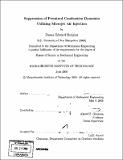Suppression of premixed combustion dynamics utilizing microjet air injection
Author(s)
Hudgins, Duane Edward
DownloadFull printable version (43.14Mb)
Other Contributors
Massachusetts Institute of Technology. Dept. of Mechanical Engineering.
Advisor
Ahmed F. Ghoniem.
Terms of use
Metadata
Show full item recordAbstract
The problem of thermoacoustic instability in continuous combustion systems is a major challenge in the field of propulsion and power generation. With the current environmental and political pressure that is being placed on the consumption of fossil fuels, this subject has become even more critical. In the past, the presence of combustion instability could be avoided by designing a combustor with fixed inlet conditions, where these conditions were conducive to a stable system. Today, utilities and providers of propulsion systems are under pressure to make systems that are not only more efficient and clean, but also have a greater flexibility of input fuel. In order to accomplish this, combustion engineers need an even deeper insight into what causes thermoacoustic instability and they need a wider array of tools at their disposal to suppress these instabilities. This thesis adds pieces of that deeper insight and provides another tool to tackle this difficult problem. As a first step in the further understanding of thermoacoustic instabilities, experiments were done in a premixed gas backwards facing step combustor using propane or propane/hydrogen mixture as a fuel. I fully characterized the combustion dynamics in this combustor by measuring the four defining states of the system. These states are pressure, heat release, velocity, and equivalence ratio. Once these measurements were performed I tested two novel approaches to suppressing thermoacoustic instabilities through the use of microjet air injection. This was done by building upon a previous combustor setup to allow the installation of several new diagnostic capabilities and the new microjets. (cont.) The new diagnostics include stand-off pressure sensors to measure pressure in the hot exhaust region, a hot wire anemometer to measure velocity, a photomultiplier tube to measure the integrated heat release, an automated gas probe to measure fuel concentration profiles, and a laser absorption sensor to measure the temporal variance in equivalence ratio. The novel microjets were built into the newly designed test section. By fully characterizing the system I was able to show how both equivalence ratio oscillations and wake vortex interactions drive the thermoacoustic instabilities of the combustion. I have also shown that the stability range shifts to leaner equivalence ratios as inlet temperature or hydrogen content in the fuel is increased. This thesis demonstrates the great potential the microjet air injection has for extending the range of stability of the system.
Description
Thesis (S.M.)--Massachusetts Institute of Technology, Dept. of Mechanical Engineering, 2008. Includes bibliographical references (leaves 119-123).
Date issued
2008Department
Massachusetts Institute of Technology. Department of Mechanical EngineeringPublisher
Massachusetts Institute of Technology
Keywords
Mechanical Engineering.